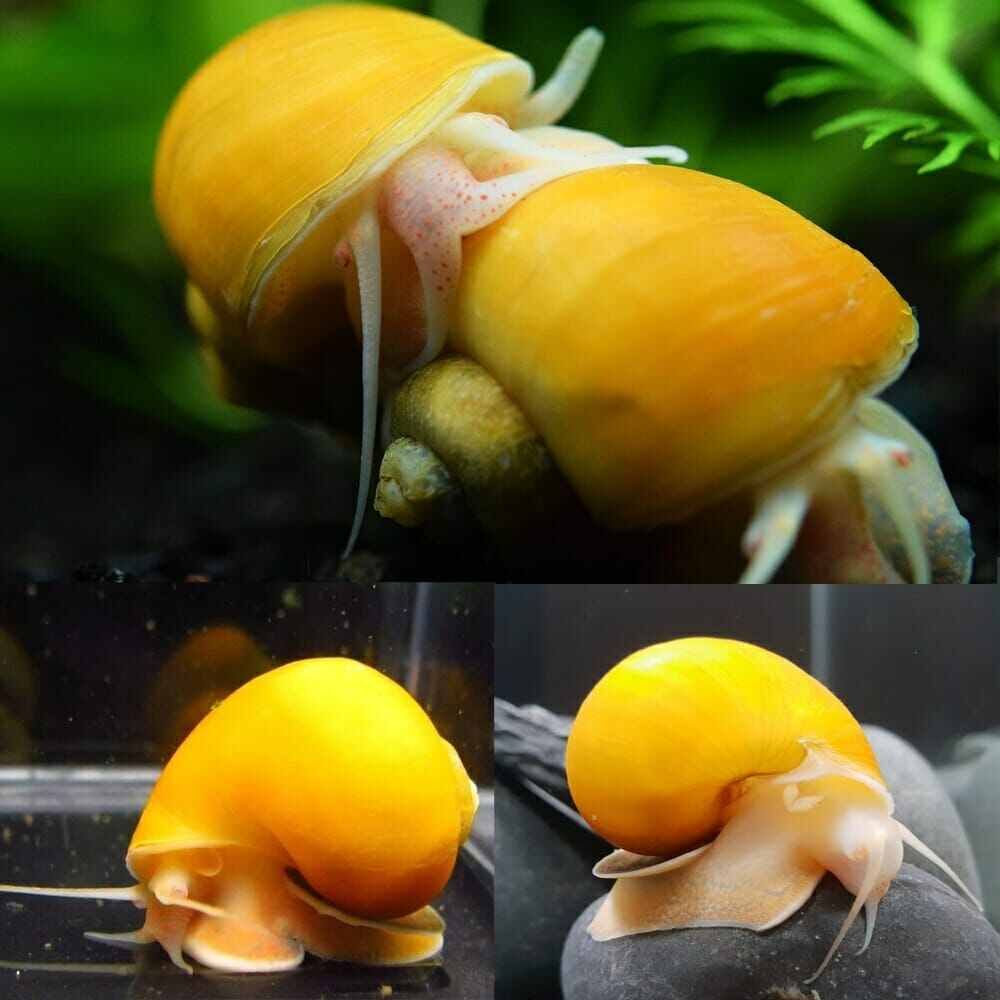The Golden Apple Snail is also known as Golden Mystery Snail. A very hardy algae eating snail for all aquarists that tolerates a wide range of water conditions but should only be introduced into a well established tank that has algae growing.
Behavior
Apple snails are most active during the night, which already indicates their preference for the darker places of their environment. During the day, they remain mostly in the shadow of plants and creep away in the bottom. When the dark comes in, the apple snail becomes more active and crawls around in search for food, a mating partner or a good place to deposit eggs. The yellow/golden apple snails tend to be more active during the daytime.
Tank Conditions
A snail has four tentacles which are very sensitive. A fine-grained, sandy substrate reduces the risk of scratching. A fine-grained, sanded, calcium type substrate is best because it means that the snails always have a good supply of calcium, which is needed for a strong shell.
The water needs to be free from ammonia and nitrites, nitrates should be less than 20 mg/L.
To keep these snails comfortable, keep your tank full of live vegetation. This not only looks nice but also gives plenty of natural food. Common plants to include are Java Fern, Java Moss, and Hornwort; all of which are incredibly hardy.
These snails tend to crawl out of the water, especially when food is low. Use a tight-fitting lid to ensure that all your snails stay in your aquarium.
Compatibility
This snail tends to keep its vulnerable body mostly inside of its shell, as opposed to other common aquarium snails; however it is advisable to house with peaceful inhabitants such as tetras, shrimp or larger fish that will mostly ignore their presence. The amount of snails you can have in your aquarium completely depends on how many fish you’re going to keep them with. As a rough indication you can include around 1 snail per 20 litres. Just make sure they have enough algae to eat.
Feeding
In the wild these snails will feed on dead and rotting plants. They will also graze on algae build up on any surface such as rocks or sand. They are very optimistic scavengers by nature, which means they will eat a wide range of food. Because of this you want to keep a medium to high level of vegetation, thus giving them a natural food source. Plants will naturally shed as they grow and this gives your snails perfect food on top of the naturally growing algae. They will suck onto the glass and eat the algae that grows off it. This is one of the biggest reasons people buy these little cleaners; keeping the glass clean for longer means less work for you.
Besides vegetables and fish food pellets, apple snails also eat all kinds of other food if available. Apple snails won’t refuse brine shrimps and other frozen foods or even dead fish and insects.
If algae isn’t forming fast enough then you should add in other foods and/or enhance algae growth by keeping your tank lights on longer. Algae wafers make good substitutes, especially since they sit on the bottom of the tank until a snail comes across them.
Care
In general one should apply the same rules for water quality as with fish (ammonia, nitrite, nitrate etc) and the water should not be too soft. Like most snails, apple snails prefer calcium rich water. If the calcium concentration in the water isn’t high enough (soft water), they aren’t able to build a strong shell and become susceptible to shell damage, but even in good conditions, some snails still get little holes in the shell surface, especially in the older parts of their shell. This is a naturally occurring process and as long it’s only at the surface, you shouldn’t worry too much about it.
As for water conditions, the numbers are straightforward:
pH level range: 7.6-8.4
Temperature range: 20°C-30°C
Water hardness: 6-18 dGH (hard is better because it has more calcium)
The thing to keep note here is the relatively high pH. Low levels of pH can start to dissolve the calcium carbonate shells of the snails leaving them open to harm from other fish. Cracked, thin, or pitted shells can be a sign of low pH as well as low levels of calcium. Adding calcium supplements (note – shrimp minerals work well) can help ensure their shells are strong and healthy.
Breeding
Apple snails reproduce throughout the warmer months. They are hermaphroditic, each snail having both sexes. Mating, however, requires two snails. They crawl out of the water at night and lay pink, calcareous masses of about 1000 eggs above the waterline on firm objects in or near the water. They will mate without any help or altered tank conditions. Once the female is ready to lay eggs, she will lay her eggs above or at the water surface. They will leave their eggs in a cocoon which makes them easy to spot and remove if you do not want babies. If they lay their eggs above the water the air surrounding the cocoon must be moist enough and eggs should hatch within a month. Baby snails will then fall to the bottom of the tank and begin their lives, eating the same food as their parents.
If you want your snails to breed, try lowering the water level a few inches to make room for them to lay eggs. Also make sure there is plenty of food as they tend to spawn only when there is enough food to feed their next generation.

